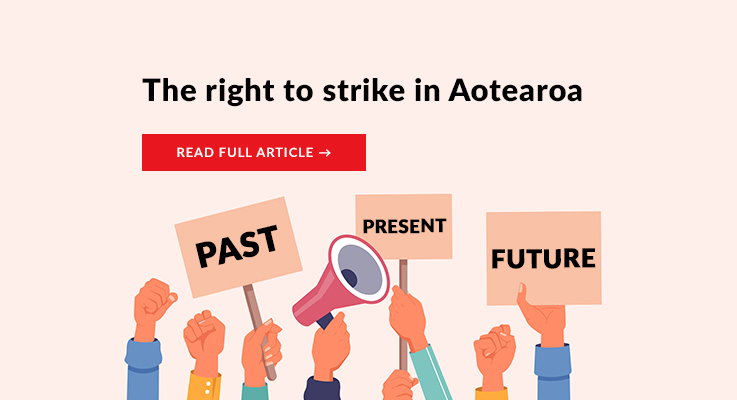Summary The year legal AI became real Voices shaping the profession A year worth remembering Contributors 2025 There's a curious phenomenon about how we experience time. When our days are...
Summary The problem with platform hopping How the models differ Security without compromise Beyond legal research The speed of adoption Originally published by NZ Lawyer . Republished...
Summary Introducing Protégé General AI General AI Models Available in Protégé for New Zealand Legal Workflows Practical Use Cases for Lawyers But as AI becomes more common in legal practice...
Summary The efficiency revolution Levelling the playing field Managing the transition carefully Specialised practice applications The evolution of legal service delivery Maintaining quality...
Summary The best in-house lawyers are pragmatic in a crisis Invest in your worst-case scenario In today’s fast-paced media environment, corporate crises demand swift, coordinated responses...

Copyright of the Employment Law Bulletin is the property of LexisNexis NZ Ltd and its content may not be copied, saved or emailed to multiple sites or posted to a listserv without the copyright holder's written permission. However, users may print, download or email articles for individual use.
This article is written by Jock Lawrie (PSA Legal Officer) and is part of Employment Law Bulletin No.6 issue, November 2024.
It is often said that a picture paints a thousand words. What is less remarked upon is that the accuracy of such words cannot always be vouchsafed and resultant impressions may mislead. What then to make of Bert Roth and Jenny Hammond’s Toil and Trouble,1 a “picture book” history of the “struggle for a better life in New Zealand”?2 Charting the nation’s industrial relations history from the early colonial era to the later decades of the 20th century, it features an account of the little-known Auckland tramwaymen’s strikes from the early 1900s. On the basis of the accompanying photos, modern readers may be surprised by the apparent depth of popular support afforded to the strikers of the time. Large crowds of passersby are seen cheering the striking workers outside the New Zealand Herald building in Auckland’s Queen Street, all the while singing a rousing chorus of “Rule Brittania”! By the book’s close, the focus has shifted to strikes such as those at Kinleith and Mangere Bridge — the names of which may still resonate for older readers given the media at the time treated such disputes as matters of national import.
Whether intentionally or not, the picture “painted” across the book’s pages is one in which strike action in New Zealand gradually became more embedded and indeed almost central to the nation’s fabric with the passing of the years. The general reader would be forgiven the impression that such a “narrative arc” could only occur in a legislative setting where the right to strike was not only protected, but actively promoted as facilitating a greater “collective good” above and beyond the immediate context in which the disputes played out.
Yet the governing legislation for the entire period under review in Toil and Trouble was starkly at odds with such a picture. The Industrial Conciliation and Arbitration Act of 1894 (IC&A Act) was perhaps notable in two principal regards. Not only did it survive largely intact for the best part of 90 years3 — outlasting periods of boom and bust including the 1930s Great Depression, two World Wars and well into the heights of the Cold War period. More importantly, for present purposes, was the fact that the IC&A Act was largely predicated on the non-availability of lawful strike action as a necessary adjunct for the right of trade unions to negotiate terms and conditions of employment on behalf of members.
In fact, the IC&A Act provided what today’s politicians might describe as “wraparound support” for trade unions by establishing a state-sponsored conciliation and arbitration process4 which effectively guaranteed regular wage movements for trade union members. Yet no provision was made under the IC&A Act for lawful strike action in support of improved terms and conditions of employment. Instead, the statute provided express statutory penalties for any such strike action.
Somewhat surprisingly, the politicians of the day did not see themselves as responsible for the removal of the right to strike on the basis that each trade union could elect as to whether or not they registered under the IC&A Act thus enabling access to the Act’s conciliation and arbitration framework. As the then Minister of Labour, J. A. Millar, stated to Parliament in 1908:5
The right to strike has not been denied by this House. If the men do not like to voluntarily surrender their rights, let them ... go on strike every day in the week; but when we pass an Act giving them advantages they could not otherwise get ... I think that it is not too much to ask that they should voluntarily carry out their agreement and not strike.
Yet even for those unions who chose not to register under the IC&A Act, the right to strike was still significantly curtailed by various statutory requirements such as those contained in the Labour Disputes Investigation Act 1913, effectively requiring any unions remaining “outside” of the IC&A Act’s conciliation and arbitration system to navigate their way through a modified, “bespoke” conciliation process and up to two state-monitored ballot processes prior to any strike action.
The eventual emergence of the right to strike as recognised today has its origins in opposing national and international developments. Nationally the conciliation and arbitration system found itself effectively becalmed, as Labour Department officials and employers stood back from enforcement of strike penalty provisions for fear of exacerbating any bargaining impasse. Indeed, the IC&A Act penalty provisions became something of “a dead letter”6 — prompting at least one commentator of the day to opine that “the present unenforced — and perhaps unenforceable — laws should be removed from the statute book and replaced by enactments which command respect and obedience by everybody”.7
At the same time there was a marked change in the international mood. The United Nations, born from the ashes of the Second World War, effectively recognised one of the hallmarks of the recently defeated Axis powers as being the legislative prohibition of trade unions and the right to strike. In consequence, the United Nations would oversee the dual protection and promotion of trade union rights to organise collectively and take strike action, principally by way of International Labour Organization (ILO) Conventions 87 and 98. Particularly significant was Convention 87, promulgated as The Freedom of Association and Protection of the Right to Organise Convention in 1948, and subsequently confirmed as providing an express right of trade unions to take strike action “in conformity with the laws of the country”.8
The last vestiges of the former conciliation/arbitration system and centralised wage negotiations were to be consigned to the dustbin of history with the election of a fourth Labour Government. A new Labour Relations Act came into effect in 1987, a time of largely bipartisan support for policies eschewing state intervention and direction in favour of market-led reform. At the same time, David Lange’s Labour Government was also eager to align the country with more recent ILO developments.
It was in this context that Parliament expressly recognised lawful strike action “subject to constraints”9 — lawful strike action was effectively reserved primarily for collective bargaining10 with an additional right, less frequently invoked, to strike in support of a redundancy agreement.11 At the same time, any strike action in consequence of a dispute, personal grievance or occupational demarcation was expressly unlawful.12 The subsequent Employment Contracts Act 1991 would effectively “double down” on the premise that lawful strike action could only arise in the context of collective bargaining, removing the right to strike for redundancy agreements and introducing the notion of “sanctity of contract” by expressly prohibiting strike action during the term of a collective agreement.13
In 2000, Helen Clark’s Labour Government introduced the Employment Relations Act 2000, which in terms of statutory objectives represented something of a high water mark for recognition of the right to strike, both indirectly — by promoting collective bargaining14 — and directly, by dint of promoting observance in New Zealand of the principles underlying ILO Conventions 87 and 98.
Yet the Employment Relations Act did not depart from the fundamental premise that in order to be lawful, strike action must relate to bargaining for a collective agreement, and moreover a collective agreement that would bind each of the employees concerned.15 While Parliament has subsequently deemed it appropriate to further circumscribe the right to strike with additional “technical requirements” relating to strike ballots and the provision of strike notice,16 a more egregious situation may be seen as applying in consequence of New Zealand’s ongoing failure to ratify ILO Convention 87.17
The Employment Relations Act effectively denies trade unions the right to mount sympathy strikes, or to invoke national strikes over social and economic issues. Yet such lawful strike action is not unreasonably seen as a necessary counterpoint to the forces of globalisation and a resultant shift in bargaining power away from employees and in favour of employers. This has long been recognised internationally and prompted the United Nations Committee of Experts to comment as early as 1994 that:18
Sympathy strikes ... are becoming increasingly frequent because of the move towards the concentration of enterprises, the globalisation of the economy and the delocalisation of work centres ... the Committee considers that a general prohibition on sympathy strikes could lead to abuse and that workers should be able to take such action, provided that the initial strike they are supporting is itself lawful.
Similarly, in 1996, the United Nations Committee on Freedom of Association stated:19
A declaration of the illegality of a national strike protesting against the social and labour consequences of the government’s economic policy and the banning of the strike constitute a serious violation of freedom of association.
While the forces of globalisation have continued unabated since that time, Parliament has yet to mitigate the adverse local effects resulting from such changes by enacting the right to strike in conformity with ILO Convention 87.
The footnotes can be accessed in Employment Law Bulletin, Issue 6, November 2024.
This article is written by Jock Lawrie (PSA Legal Officer) and is part of Employment Law Bulletin No.6 issue, November 2024.
To enquire about Employment Law Bulletin subscription, submit the form below:





